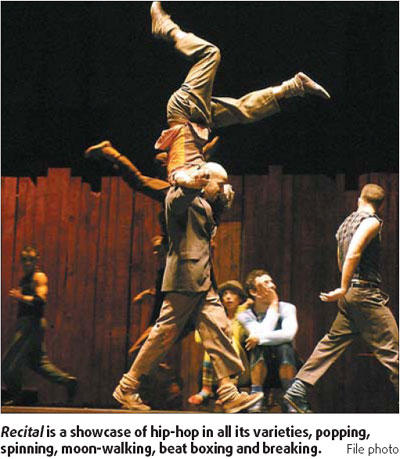Hip-hop dancers kick out the jams
Mourad Merzouki was sent to a circus school in Lyon when he was 7, because his father wanted him to learn some discipline. Little did he know that one day his son would be at the forefront of the international hip-hop dance scene.
With a background in circus and having studied with the modern-dance choreographer Maryse Delente and Guy Darmet, artistic director of the Lyon Dance Biennial, Merzouki's style combines acrobatics, martial arts, hip-hop and many other influences.
The 34-year-old Frenchman says he wants to prove that hip-hop dance is about improvisation and that it can go in all directions.

Tonight, one of Merzouki's trademark works Recital will run at the Haidian Theater in Beijing.
In one hour, the 11 dancers, five from China's Sichuan Song and Dance Company, four from Beijing Modern Dance Company (BMDC), Merzouki and a dancer from his Kafig company will showcase hip-hop in all its varieties, popping, spinning, moon-walking, beat boxing and breaking.
The dancers pretend to play violins, embodying a visual orchestra. As for the music, Franck II Louise's score is a fusion of North African melodies and beat boxing.
Merzouki first created Recital in 1998 and over the last 10 years he has revised it every time he has worked with a different company.
The collaboration with BMDC was initiated by the French Culture Center, which organizes the annual Festival Croisements from April to June in China. They sent the video of BMDC's shows to Merzouki and asked whether he would like to work with the Chinese dancers.
"I was impressed by their energy, power and the way they dance, so I said yes," Merzouki says.
"Actually I always enjoy working with dancers from different countries and cultural backgrounds, because they bring with new vision and help me develop new choreography and approaches to hip-hop.
"For me, to put together a show with people from different origins, ages and cultures is the best way to make possible a meeting, or dialogue, between people.
"The Chinese dancers are very open-minded and are in perfect physical condition. They are eager to learn and learn very fast, even learn faster than my dancers in France."
In 1996, Merzouki established the Company Kafig, an Algerian word for cage. Most of the dancers are of North African descent.
"What is interesting in the hip-hop culture, from my point of view, is the ability to change negative energy into positive energy. That is what Kafig does," he says.
(China Daily 04/15/2008 page19)














